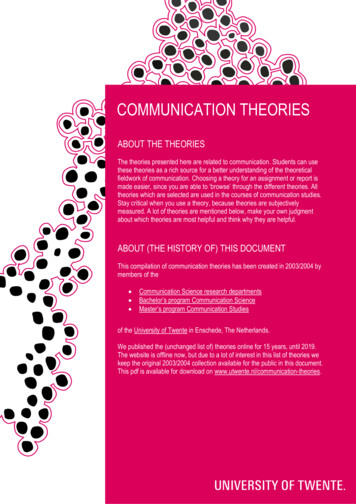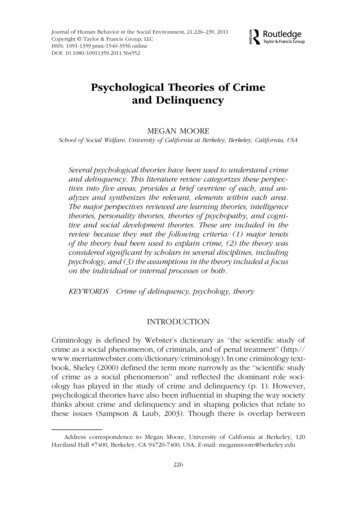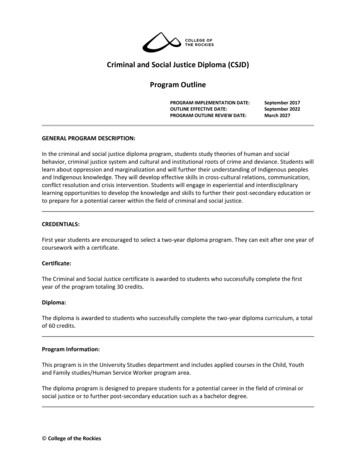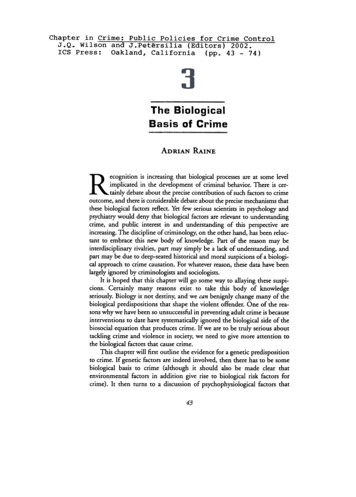
Transcription
Psychology of Criminal Behaviour A Canadian Perspective Canadian 2nd Edition Brown Solutions ManualFull Download: d-editionPsychology of Criminal Behaviour: A Canadian Perspective (2nd Ed.)Chapter 2: Biological and Evolutionary ExplanationsCHAPTER 2: THEORIES OF CRIME: BIOLOGICAL ANDEVOLUTIONARY EXPLANATIONSLEARNING OBJECTIVES1. Describe the range of biological explanations of crime, including genetics,neurochemistry, hormones, psychophysiology, and more.2. Explain the basic principles of evolutionary psychology and demonstrate how theseprinciples are used to understand crime in general as well as specific forms of crimeand specific types of criminal offenders.3. Demonstrate that biological and evolutionary theories of crime are as much about theenvironment as they are about biology and evolution.4. Demonstrate that biological and evolutionary explanations are not incompatible withtraditional theories of crime (e.g., social learning theory, presented in Chapter 3), butrather are complementary.CHAPTER SUMMARYThere are multiple pathways to crime. This chapter has focused on evolutionary andbiological explanations. Multiple pathways exist within each perspective includingbiological factors such as genetics, neurochemistry, hormones, and psychophysiology.Evolutionary perspectives are complex and comprised of a series of micro-evolutionarytheories (e.g., life history theory and frequency dependent selection).Biological and evolutionary explanations of crime underscore the importance of theenvironment. Environmental insults (e.g., a mother who drinks during pregnancy) changethe biological makeup of an individual such that he or she is now predisposed to a futurecriminal lifestyle. A distant environment shaped evolutionary mechanisms. Evolutionitself determined our minds such that they adapt and change to current environmentalcues. The theory of evolution has more in common with environmental theories such associal learning (discussed in Chapter 3) than one might think. The only difference is thatevolution focuses on the learning environment of the entire species whereas sociallearning theories focus on the learning environment of an individual.It is a myth that evolutionary accounts of crime contradict traditional theories.Evolutionary perspectives simply focus on providing ultimate explanations, whiletraditional criminological theories focus on more proximate explanations. Theseperspectives tend to complement rather than contradict. When theories do diverge itindicates that one perspective is incorrect.This chapter has shown that research unequivocally supports the influence of genetics oncriminality. It has also demonstrated that the path to crime is complex and that a numberof biological subsystems interact with one another to increase risk of future criminality,with the environment greatly influencing whether certain biological predispositions willmanifest. Evolution is uncontested in scientific circles; however, evolutionaryCopyright 2017 Pearson Canada Inc.Full download all chapters instantly please go to Solutions Manual, Test Bank site: testbanklive.com16
Psychology of Criminal Behaviour: A Canadian Perspective (2nd Ed.)Chapter 2: Biological and Evolutionary Explanationspsychology, in particular, evolutionary forensic psychology, is in its infancy. Moreresearch from different perspectives is required.The link between evolutionary and biological explanations of crime is a natural one.In the evolution section, we focused on psychological mechanisms that have evolved inresponse to ancestral selection pressures. This does not negate the existence of evolvedbiological mechanisms such as those reviewed in the first part of the chapter.LECTURE OUTLINE1. Introduction This chapter focuses on biological and evolutionary explanations for antisocialbehaviour, crime, and violence. Biological explanations are varied and include genetics, brain neurochemistry, anddiet for example. Evolutionary psychology principles will be described and used to explain certaintypes of offenders including psychopaths and crimes such as homicide. Paradoxically, biological and evolutionary explanations include the environment. Discussions will explore how our past hunter and gatherer ancestral environmentshaped the evolution of the human species and how it continues to influence ourbiology.2. Context Lombroso (1835-1909) is commonly known as the “father of criminology.” Lombroso argued that criminals possess distinctive physical features (e.g., slopingforeheads and twisted lips not observed in his “normal” subjects). Lombroso referred to these features as atavisms and suggested that criminals wereevolutionary throwbacks who had more in common with Neanderthals than modernday man. Darwin published On the Origins of Species in 1859, almost 17 years beforeLombroso published the first volume of The Criminal Man. Darwin posited that humans evolved from ancestral species via the mechanisms ofnatural selection. Darwin’s cousin, Galton, misused Darwin’s work and founded eugenics – the theoryultimately responsible for not only the forced sterilization (or worse) of thousands of“unfit” individuals in the United States during the early part of the twentieth centurybut also the atrocities under Hitler’s regime (forced abortion, sterilization, and deathcamps).3. Definitions Defining crime is a complex task. Some researchers examine the link between biology and crime by comparing normalindividuals to individuals who have been officially diagnosed with antisocialpersonality disorder (ASPD), conduct disorder (CD), or psychopathy.Copyright 2017 Pearson Canada Inc.17
Psychology of Criminal Behaviour: A Canadian Perspective (2nd Ed.) Chapter 2: Biological and Evolutionary ExplanationsOther researchers use measures of aggression or composite indices of antisocialbehaviour obtained via self-report surveys or, in the case of children, parents/teachers.Researchers often define crime using current legal definitions and examine whetherbiological factors correlate/predict official criminal offending in the form ofarrests/convictions.Target of study vary, focusing on males, females, children, adolescents, or specificgroups such as violent or sexual offenders.4. Why Do We Care? What Makes a Strong Theory?: Numerous textbooks and experts have defined the meaning of theory. The definition here represents an amalgamation of perspectives: a theory is anexplanation of a particular phenomenon. A strong theory:1. is parsimonious;2. clearly identifies the causal mechanisms and corresponding mediators andmoderators underlying the phenomenon of interest;3. is testable and hence falsifiable via hypotheses and predictions;4. is based on empirical data and modified in response to new data;5. possesses interdisciplinary compatibility; and6. respects gender, ethnicity, and culture. It is helpful to ask, “Does this perspective provide a good theory of crime?” Forexample, are certain explanations stronger (causal evidence is presented versuscorrelational evidence).5. Methodology How is Biology-Focused Research Conducted?: Behavioural genetics researchers use twin methodology to ask whether identical twinsare more likely to commit crime than non-identical twins. Molecular biologists compare the genetic makeup of a group of “criminals” to one of“non-criminals” to look for distinct genetic differences between the two. Neurochemical approaches examine how genes actually express themselves in termsof the brain’s neurotransmitter systems. Other researchers rely on brain-imaging techniques such as computer tomography(CT) to assess brain functions and impairment in antisocial individuals.6. Biological Theories of CrimeGenetics and Crime - Twins, Adoption, and Molecular Genetics:Twin Studies:To examine the role that genetics plays in criminal conduct, it is necessary to employmethodologies that allow researchers to separate genetic and environmentalinfluences.Behavioural genetics relies heavily on the study of twins and adoptions that can helpseparate genetic from environmental influences (to some degree).Copyright 2017 Pearson Canada Inc.18
Psychology of Criminal Behaviour: A Canadian Perspective (2nd Ed.) Chapter 2: Biological and Evolutionary ExplanationsEvery human being shares about 99 percent of his or her DNA sequence with the restof the human species.The 99 percent of every human’s DNA is shared with the rest of the human speciesand is fixed (not free to vary) and accounts for our basic similarities.Behavioural genetics focuses on the remaining 1 percent of human DNA that is freeto vary.Monozygotic (MZ), or identical twins, are genetically identical and share 100 percentof their genes (including the free to vary 1 percent).Dizygotic (DZ), or fraternal twins are no more alike than non-twin siblings, sharingon average about 50 percent of the 1 percent that is free to vary.Frequency of criminal behaviour is converted into a concordance rate that representsthe percentage of both twins classified as criminal.Concordance rates would be calculated separately for MZ and DZ twins and thencompared.A concordance rate of 30 percent for the DZ twins would mean that if one of the DZtwins was criminal, then there was 30 percent chance that the other DZ twin was alsocriminal.Evidence for a genetic contribution to crime is inferred if concordance rates arehigher between MZ than DZ twins.Concordance rates are typically converted into a heritability coefficient—adescriptive statistic that represents the proportion of phenotypic variance in a givenbehaviour (e.g., criminal) that can be attributed to genetic variation amongindividuals.More complex statistical approaches such as biometric modeling have been used toestimate heritability coefficients.Statistical modeling methods permit the estimation of two types of environmentalfactors:1. shared environmental factors (i.e., aspects of the environment shared by all familymembers, such as living in poverty) and2. non-shared environmental factors (i.e., aspects of the environment not shared byall family members, such as exposure to different peer groups or differentialtreatment by parents.Genetic studies are as much about genes as they are environment.This type of twin study may overestimate or underestimate the genetic contributionfor several reasons:1. parents are more likely to provide similar environments for MZ twins than theirDZ counterparts;2. heritability estimates for MZ twins may be confounded by prenatal factors that bydefinition aren’t necessarily genetic e.g., MZ twins usually share one placenta andDZ twins usually have two separate placentas; and3. earlier twin studies were also criticized for using small sample sizes and for beingsubject to political influence.Adoption Studies:Adoption research has taken one of two forms:Copyright 2017 Pearson Canada Inc.19
Psychology of Criminal Behaviour: A Canadian Perspective (2nd Ed.) Chapter 2: Biological and Evolutionary Explanations1. Parent – offspring: concordance rates (or correlations) between adoptive parentsand adoptees’ antisocial behaviour are compared to concordance rates (orcorrelations) between biological parents and adoptees. If the concordancerates/correlations are higher for the biological parents and the adopted offspringthan the adoptive parents and the adopted offspring, genetic contributions toantisocial behaviour are inferred.2. Sibling – offspring: concordance rates between adoptive siblings are comparedwith concordance rates between biological siblings.One strong adoption study of 14 427 non-familial adoptions in Demark between 1924and 1947 found:1. if both the biological and adoptive parents had no criminal record, then only 13.5percent of adopted sons had criminal records;2. if the adopted parent had a criminal record and the biological parent did not, thispercentage increased marginally to 14.7 percent;3. if the biological parent had a criminal record and the adoptive parent did not, thispercentage rose to 20 percent; and4. if both biological and adoptive parents had a criminal record the percentage wasthe highest at 24.5 percent.The Danish study demonstrates that genes play a role in explaining crime and thatenvironmental effects are important.A meta-analysis of 10 independent adoption samples and 42 independent twinsamples studies (55 525 total participants) show the variance in antisocial behaviourcan be divided as follows: heritability (41 percent) shared environment (16 percent),and non-shared environment (43 percent).Both genetics and the environment contribute to variance in antisocial behaviour.Research increasingly shows that the gene–crime link is most likely not direct butrather a function of the mediational effects of inherited characteristics that predisposean individual to antisocial behaviour (e.g., lower intelligence, impulsivity, attentiondeficit hyperactivity disorder).Pathways to antisocial behaviour are not usually direct nor unidimensional.Genetics might reduce or magnify the effects of environmental risk factors.Behavioural geneticists ask if there may be interactive effects between genes and theenvironment (gene X environment effect).The evidence demonstrates that childhood maltreatment (e.g., physical abuse,emotional abuse, sexual abuse, neglect) contribute to the development of antisocialand criminal behaviour.Less clear is why 50 percent of maltreated children do not engage in delinquency,aggressive behaviour, or criminality.One twin study used a genetic risk continuum (low to high risk) in studying conductdisorder. The experience of maltreatment increased the probability of the childreceiving a conduct disorder diagnosis by 1.6 percent among children deemed lowestgenetic risk and 23.5 percent for children deemed high genetic risk.Molecular Genetics Research:Twin and adoption studies illustrate that there is a clear link between genetics andantisocial behaviour (the actual functional gene(s) involved have not been identified).Copyright 2017 Pearson Canada Inc.20
Psychology of Criminal Behaviour: A Canadian Perspective (2nd Ed.) Chapter 2: Biological and Evolutionary ExplanationsThe main function of a gene is to produce proteins comprised of amino acids – thebasic building blocks of life.Proteins are responsible for the phenotypic expression of our genotype.Faulty genes either reduce too much or too little of a particular protein.Human genes are stored in 46 chromosomes (23 pairs).Caspi and colleagues (2002), using an epidemiological study, demonstrated aninteraction between a specific gene (monoamine oxidase A [MAOA], a sex-linkedgene) and a well-known risk factor – childhood maltreatment.The MAOA gene is responsible for encoding the MAOA enzyme, which isresponsible for metabolizing key brain neurotransmitters such as norepinephrine(NE), serotonin (5-Ht), and dopamine (DA), all of which have been implicated inaggression and various forms of antisocial behaviour.The two existing versions of the MAOA gene—low activity and high activity—arethe result of a polymorphism.Researchers found evidence for a strong gene by environment interaction across allfour measures of antisocial behaviour—conduct disorder, violent convictions, violentdisposition, and antisocial personality disorder symptoms.While maltreatment by itself had deleterious effects, its effects were exacerbated bythe presence of a low-activity MAOA gene.Thus there is increasing evidence that the low-activity version of the MAOA geneplays a significant role in the expression of antisocial behaviour, particularlyaggression and violence when maltreatment is present.Neurochemistry and Crime—Hormones and Neurotransmitters:Genes are largely responsible for the expression of hormones and neurotransmitters.The endocrine system regulates hormone production and distribution.The nervous system regulates the production and function of neurotransmitters.Hormones and Crime:The endocrine system governs more than 50 hormones.Hormones are released into our bodily fluids typically via the bloodstream.Hormones not only regulate metabolism, growth, and development, they also impactbehaviour.Imbalances may be minor, resulting in mood swings, or severe, resulting in seriousillness or death.Testosterone is a steroidal hormone of the family of androgens responsible fordeveloping and maintaining male primary and secondary sexual characteristicsTestosterone is implicated in criminal behaviour, violence and aggression,Two meta-analyses have found a positive correlational relationship betweentestosterone and aggression; however the average effect size is relatively small.The relation between testosterone and aggression is complex (and far from causal)and most likely indirect in the expression of aggression and antisocial behaviour.Neurotransmitters and Crime:Neurotransmitters are chemical messengers that operate in the brain and are themessengers of the nervous system.Neurons or nerve cells transmit commands from one part of the body to another andneurotransmitters play a critical role in this communication process.Copyright 2017 Pearson Canada Inc.21
Psychology of Criminal Behaviour: A Canadian Perspective (2nd Ed.) Chapter 2: Biological and Evolutionary ExplanationsThere are two types of neurons: pre-synaptic (senders) and postsynaptic (receivers).The postsynaptic cell receives messages using its dendrites.Narrow gaps or synapses exist between the pre-synaptic and postsynaptic cells.Some of these synapses are electrical and some are chemical (electric impulses areconverted to chemical signals by the neurotransmitters).An electrical impulse travels along the presynaptic cell but cannot cross the synapticcleft to the postsynaptic cell without being temporarily converted into a chemicalsignal, the neurotransmitter.Neurotransmitters are stored in synaptic vesicles.Three neurotransmitters in particular have been studied in relation to crime as relatedto information processing, mood regulation, and communication: serotonin,dopamine, and norepinephrine.SerotoninThe neurotransmitter serotonin plays an important role in behavioural inhibition andmood regulation.Serotonin is produced from the essential amino acid, tryptophan.Tryptophan is not produced naturally within the body but must be obtained from diet(protein-based foods such as turkey and chocolate).There is a link between a malfunctioning serotonin system and impulsivity,irritability, and aggression (towards self/others) – found in studies that operationalizemalfunctioning serotonin systems as low levels of serotonin, low levels of itsprecursors such as tryptophan, low levels of its metabolites, and faulty serotoninreceptor sites on the postsynaptic neuron.Serotonin, its precursors, and metabolites are measured in blood, urine, andcerebrospinal fluid (CSF). CSF studies are considered the most reliable.One meta-analytic review of 16 studies illustrated that serotonin levels weresubstantially lower among antisocial individuals than non-antisocial individuals (witheffect size unrelated to gender, target of violence, history of suicide, or alcoholism).Results confirmed a moderate (positive) correlation between blood serotonin levelsand violent criminal behaviour but it must be kept in mind the studies werecorrelational in nature and based on predominantly non-random and small samples(less than 30).Research clearly suggests that there is a correlation between a malfunctioningserotonin system and aggression; however the extent to which serotonin is predictiveor causally related to violence/aggression requires further study.Newer studies that artificially manipulate tryptophan to examine the impact onaggression (in laboratory setting) suggest a causal link; however more studies areneeded as this study is preliminary and requires replication.Other studies show low levels of serotonin increase impulsivity (a known correlate ofaggression) and suggest serotonin may exert its influence indirectly on aggressionthrough the mediator of impulsivity or negative mood.Psychophysiology and Crime:A psychophysiological theory uses physiology (e.g., low resting heart rate) to explainpsychological constructs (e.g., emotions, motivation, and learning).Copyright 2017 Pearson Canada Inc.22
Psychology of Criminal Behaviour: A Canadian Perspective (2nd Ed.) Chapter 2: Biological and Evolutionary ExplanationsVarious theories have tried to link measures of autonomic response (e.g., heart rate,electrodermal activity/galvanic skin response/skin conductance) to various measuresof antisocial conduct.Electrodermal activity (EDA) measures the amount of electrical current between twopoints on the skin.Increases in heart rate and EDA are related to general emotional responses such asfear, anger, or anxiety.Two meta-analyses show a small to moderate correlation between various indices ofantisociality and low levels of autonomic arousal.Individuals who engage in antisocial behaviour have a tendency to exhibit low heartrates and low EDA.Two competing theories have been developed to explain these findings: fearlessnesstheory and stimulation-seeking theory.Fearlessness theory argues some individuals do not experience much fear whenstressed thus these individuals possess the requisite level of fearlessness to engage incrime.Some research suggests children who experience chronic childhood stressors learn tohabituate to life stress and are predisposed to fearlessness and a proclivity toantisocial conduct.Stimulation-seeking theory explains the relationship between low resting heart rateand aggression as a need for stimulation. Individuals find their chronic state of lowarousal as unpleasant and seek to alleviate it by engaging in risky activities includingcrime.The Brain and Crime - Neuroimaging and NeuropsychologyThe story of Phineas Gage is the first documented natural experiment linking thebrain to personality and behaviour.Scientists have since accumulated much knowledge about the brain and antisocialbehaviour using brain imaging studies and neuropsychology.Brain Imaging:Brain imaging (neuroimaging) research examines the structural (e.g., size of greymatter, tumours, lesions) and functional characteristics (e.g., blood flow, glucosemetabolism) of the brain.Brain structure is typically studied with magnetic resonance imaging (MRI) andcomputed tomography (CT), while brain function is studied through positronemission tomography (PET) and single photon emission computed tomography(SPECT).Brain imaging studies are complex and diverse and involve assessing a small numberof known antisocial individuals to a comparison group.Earlier studies compared brain structures and/or functions of the two groups.Recent studies have compared brain function while test subjects were engaged in acognitive activity (such as viewing emotionally negative pictures).A meta-analysis by Yang and Raine (2009) concluded that functional and structuralimpairments to the prefrontal cortex are more common among antisocial populationsthan comparison groups.Copyright 2017 Pearson Canada Inc.23
Psychology of Criminal Behaviour: A Canadian Perspective (2nd Ed.) Chapter 2: Biological and Evolutionary ExplanationsThree areas in the pre-frontal cortex responsible for regulating emotional processing,decision-making, impulse control, and cognitive flexibility are more likely to beimpaired among antisocial populations.While this body of research is intriguing, it has been built on small samples ofincarcerated offenders (predominantly sex and violent offenders) and is typicallywithout non-criminal comparison groups which precludes the ability to determinewhether brain abnormalities cause antisocial behaviour or whether engaging inantisocial behaviour changes the structure and/or function of the brain.Neuropsychology:Neuropsychology studies brain function indirectly using a battery of paper/penciland/or motor tests designed to diagnose what part of the brain is malfunctioning.Experts in the field of neuropsychology have studied whether deficits in executivefunctioning (cognitive functioning involving future goal-oriented behaviour,purposive attention, organizational skills, and inhibitory control) are related toantisocial behaviour.While these functions have been associated with the frontal lobe other components ofthe brain such as the connector pathways also play a role.Two narrative reviews reached inconclusive results regarding the link betweenexecutive functioning and antisocial behaviour but a recent meta-analytic studyshowed a robust effect indicating that poor executive functioning is related toantisocial behaviour; however there was considerable variability from study to study.Other Biological Considerations—Pregnancy, Birth Complications, Toxins, and Diet:Certain environmental insults change our biology in a manner that heightens ourpropensity toward antisocial behaviour.Inadequate prenatal (during pregnancy) conditions, perinatal (during birth)complications, improper diet, and environmental toxins (e.g., lead) result in changesto our biology that may in turn make us more likely to engage in antisocial behaviour.There is some evidence of a link between hypoglycemia (low blood sugar—known toresult in panic, irritability, nervousness) and aggression and antisocial behaviour.In a double-blind study the effects of a healthy, sugar-reduced diet were found toreduce antisocial behaviour by 48 percent.Researchers investigated the impact of lead neurotoxins on brain developmentdetermining that while there was no effect at the age of 7 in boys, elevated levels oflead were linked with significant increases in antisocial behaviour by the age of 11even when controlling for other factors such as socioeconomic status and parentalquality.Abnormal fetal development due to a variety of factors including maternal smoking,drinking, fetal alcohol spectrum disorder, poor nutrition, and birth complications maypredispose an individual to antisocial behaviour.Hypoxia or lack of oxygen to the brain at birth can have a profound impact ondevelopment, increasing the probability of learning disabilities, impaired cognitivefunctioning, and intelligence.The environment (e.g., positive parenting) can reverse the potentially deleteriouseffects associated with pregnancy and birth-related insults and thus serve to protectCopyright 2017 Pearson Canada Inc.24
Psychology of Criminal Behaviour: A Canadian Perspective (2nd Ed.) Chapter 2: Biological and Evolutionary Explanationsindividuals from their biology and the environment (e.g., poor parenting) canaggravate biological risk such as children born with subtle neurological impairments.It is important to underscore the complex interactions occurring within the biologicalsubsystems as well as between them.Complex interactions occur at the environmental level (e.g., the positive impact ofdiet on hyperactive children is magnified when accompanied by a supportive homeenvironment).It is critical to ascertain how all the factors fit together to determine the true causalrisk factors, mediators, and moderators that will result in a stronger theory of crimeand in turn lead to efficient allocation of limited treatment resources.7. Evolutionary Theories of Crime Proximate explanations identify which factors in a person’s immediate environmentcause certain behaviours and how the behaviour develops over an organism’s lifespan(questioning causation and development at the individual level). Ultimate or distal explanations ask questions about function and adaptation for anentire species. Darwin made two critical points in his book: 1) species did not always exist in theircurrent form but rather evolved or transformed from ancestral species; and 2) theevolutionary mechanism for this transformation was natural selection. Evolution 101: Natural Selection, Adaptation, and Beyond: Evolutionary psychology seeks to understand human psychology from a Darwinianperspective. Evolutionary perspective has been applied to a vast array of psychological constructsranging from altruism, phobias, emotions, group dynamics, and antisocial behaviour. Evolutionary psychology posits that the human mind comes equipped with numerouspsychological mechanisms that have been designed and maintained through selectionover thousands of years of evolution. These psychological mechanisms are sometimes conceptualized as a series of minicomputer programs that have been designed by one master programmer (theenvironment itself). Our ancestral environment was comprised of various selection pressures and adaptiveproblems—finding a mate, hunting, gathering, protecting children, avoidingpredators, and finding shelter. “Hunters” and “gatherers” who successfully responded to adaptive problems and/orselection pressures not only survived, but lived long enough to reproduce childrenand pass these successful adaptations on to the next generation. Unsuccessful responses resulted in death or reduced capacity to reproduce. Successful adaptation – be it biological or psychological – is housed in anindividual’s genetic makeup, so the only way adaptations can be passed on is throughgenetic rather than cultural transmission. A prerequisite to becoming a potential adaptation is that the “candidate” adaptationmust first appear in the organism’s genetic makeup by chance or a genetic mutation. If the mutation enhances the organism’s reproductive fitness – how good an organismis at reproducing plentifully and keeping offspring alive long enough for them toCopyright 2017 Pearson Canada Inc.25
Psychology of Criminal Behaviour: A Canadian Perspective (2nd Ed.) Chapter 2: Biological and Evolutionary Explanationsreproduce - it will be retained and passed on to the next generation and eventuallymake it’s way into the specie
The link between evolutionary and biological explanations of crime is a natural one. In the evolution section, we focused on psychological mechanisms that have evolved in response to ancestral selection pressures. This does not negate the existence of evolved biological mechanisms such as those reviewed in the first part of the chapter.











